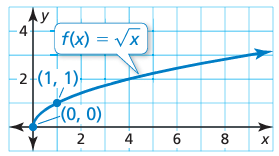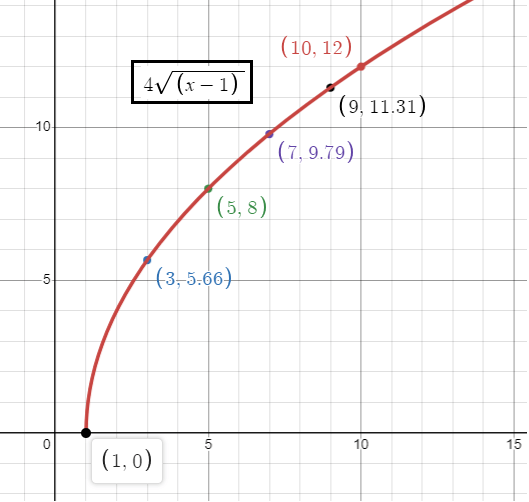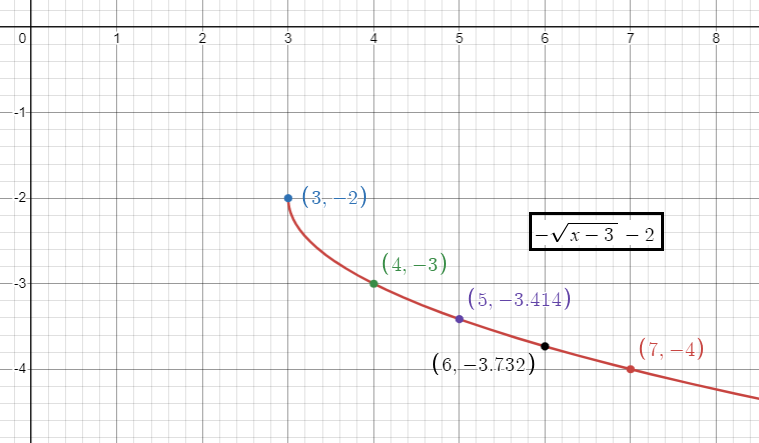FIND INCREASING AND DECREASING INTERVALS FOR SQUARE ROOT FUNCTION
Subscribe to our ▶️ YouTube channel 🔴 for the latest videos, updates, and tips.
To find increasing or decreasing interval for a square root function, we have to follow the procedure given below.
Step 1 :
Find the domain. To find domain, we have to fix the radicand ≥ 0 and solve for x.
Step 2 :
It is necessary to remember the parent graph of the square root function √x.

Step 3 :
Make sure is there any reflection.
The given square root function can be considered as
a - Vertical stretch / compression by the factor of a
- If a > 1, then vertical stretch
- If 0 < a < 1, then vertical compression.
b - Horizontal stretch / compression by the factor of b.
- If b > 1, then horizontal compression
- If 0 < b < 1, then horizontal stretch.
h - Horizontal move towards left or right
- If h is positive, then move right of h units
- If h is negative, then move left of h units.
k - Vertical move towards up or down.
- If k is positive, then move up k units.
- If h is negative, then move down k units
Note :
Sign of a and b will decide if there is any reflection or not.
- If a is negative, then reflection across x-axis
- If b is negative, then reflection across y-axis.
Is the function increasing or decreasing on its domain and describe the transformations from the graph of f (x) = √x to the graph of h. Then graph h.
Problem 1 :
Increasing in the interval [1, ∞).
Solution :
h(x) = 4√(x - 1)
Domain :
√(x - 1) ≥ 0
x - 1 ≥ 0
x ≥ 1
Domain is [1, ∞).
Increasing / decreasing interval :
There is no reflection, then as x increase the value of y will also increase. It must be increasing function in the interval [1, ∞).
Graphing h(x) :
Here a = 4 > 1, then vertical stretch of 4 units.
h = 1, then horizontal move 1 unit to the right. Then the starting point of the function is (1, 0).
By applying some random values of x, we draw the graph.
|
x 3 5 7 9 10 |
4√(x - 1) 4√2 = 5.656 8 4√6 = 9.79 4√8 = 11.31 4√9 = 12 |

Problem 2 :
Solution :
h(x) = 2√-x - 6
Domain :
√-x ≥ 0
-x ≥ 0
x ≤ 0
Domain is (-∞, 0].
Increasing / decreasing interval :
b is negative, reflection across y-axis. Decreasing in the interval (-∞, 0].
Graphing h(x) :
Here a = 2 > 1, then vertical stretch of 2 units.
k = -6, then vertical move of 6 units down. Then the starting point of the function is (0, -6).
By applying some random values of x, we draw the graph.
|
x -5 -4 -3 -2 -1 |
2√(-x) - 6 2√5 - 6 = -1.52 -2 2√3 - 6 = -2.53 2√2 - 6 = -3.17 2√1 - 6 = -4 |

Problem 3 :
Solution :
h(x) = -√(x - 3) - 2
Domain :
√(x - 3) ≥ 0
x ≥ 3
Domain is [3, ∞).
Increasing / decreasing interval :
a is negative, reflection across x-axis. Decreasing in the interval [3, ∞).
Graphing h(x) :
There is no stretch or shrink.
h = 3, horizontal move of 3 units to the right and k = -2, then vertical move of 2 units down.
By applying some random values of x, we draw the graph.
|
x 3 4 5 6 7 |
-√(x-3) - 2 -2 -3 -√(5-3) - 2 = -3.414 -√(6-3) - 2 = -3.732 -√(7-3) - 2 = -4 |

Subscribe to our ▶️ YouTube channel 🔴 for the latest videos, updates, and tips.
Recent Articles
-
Finding Range of Values Inequality Problems
May 21, 24 08:51 PM
Finding Range of Values Inequality Problems -
Solving Two Step Inequality Word Problems
May 21, 24 08:51 AM
Solving Two Step Inequality Word Problems -
Exponential Function Context and Data Modeling
May 20, 24 10:45 PM
Exponential Function Context and Data Modeling